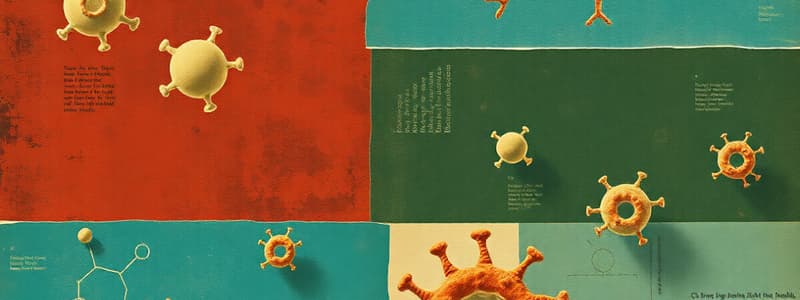Podcast
Questions and Answers
Enzymes are often named by adding -ase to the ______.
Enzymes are often named by adding -ase to the ______.
substrate
The enzyme lactase catalyzes the breakdown of ______.
The enzyme lactase catalyzes the breakdown of ______.
lactose
Enzyme nomenclature begins with the abbreviation ______.
Enzyme nomenclature begins with the abbreviation ______.
EC
The first digit of the EC number represents the ______ of the enzyme.
The first digit of the EC number represents the ______ of the enzyme.
Lipase is an enzyme responsible for breaking down ______.
Lipase is an enzyme responsible for breaking down ______.
The concentration of ______ can influence enzyme action and activity.
The concentration of ______ can influence enzyme action and activity.
Factors like temperature and pH are important for maintaining optimal enzyme ______.
Factors like temperature and pH are important for maintaining optimal enzyme ______.
Protease is involved in breaking down ______.
Protease is involved in breaking down ______.
Cellulase breaks down ______, which is a component of plant fibers.
Cellulase breaks down ______, which is a component of plant fibers.
Environmental hazards can act as ______ for enzymes.
Environmental hazards can act as ______ for enzymes.
Enzymes are complex organic compounds that have the ability of speeding up ______ reactions.
Enzymes are complex organic compounds that have the ability of speeding up ______ reactions.
Enzymes are very specific and will only catalyze one specific chemical ______.
Enzymes are very specific and will only catalyze one specific chemical ______.
The molecules that bind to the enzyme are called ______.
The molecules that bind to the enzyme are called ______.
The area on the enzyme where the substrate binds is known as the ______.
The area on the enzyme where the substrate binds is known as the ______.
An intermediate compound formed when the enzyme and substrate bind is called an - complex.
An intermediate compound formed when the enzyme and substrate bind is called an - complex.
The model that states the shape of the substrate and enzyme fit together like a key in a lock is called the ______ model.
The model that states the shape of the substrate and enzyme fit together like a key in a lock is called the ______ model.
The model proposed by Daniel E. Koshland, Jr., in 1958 is known as the ______ fit model.
The model proposed by Daniel E. Koshland, Jr., in 1958 is known as the ______ fit model.
Coenzymes are considered ______ molecules that assist enzymes in their function.
Coenzymes are considered ______ molecules that assist enzymes in their function.
Cofactors may be either organic or ______ molecules.
Cofactors may be either organic or ______ molecules.
Without a specific enzyme, a chemical reaction may hardly ______ at all.
Without a specific enzyme, a chemical reaction may hardly ______ at all.
Flashcards are hidden until you start studying
Study Notes
Importance and Nature of Enzymes
- Enzymes are complex organic compounds essential for catalyzing chemical reactions in the body without undergoing permanent changes.
- Specificity is a key feature; each enzyme catalyzes only one specific reaction and remains unchanged post-reaction.
Structure and Function of Enzymes
- Enzymes interact with substrates, fitting together at an active site, similar to a puzzle.
- The binding of the substrate to the active site forms an enzyme-substrate complex, which then transforms into products.
Modes of Enzyme Action
- The process starts when the substrate contacts the enzyme's active site.
- A temporary enzyme-substrate complex forms, leading to the conversion of the substrate into products, which are subsequently released.
- The enzyme is restored to its original state after the reaction.
Models of Enzyme Action
Lock and Key Model
- Proposed by Emil Fischer in 1894, suggesting that the enzyme's active site and substrate fit together rigidly like a key in a lock.
Induced Fit Model
- Proposed by Daniel E. Koshland, Jr. in 1958, indicating that substrate binding alters the enzyme's active site shape, facilitating the reaction.
Coenzymes and Cofactors
- Coenzymes are organic molecules that aid enzyme function, whereas cofactors can be organic or inorganic substances that assist without binding tightly to the enzyme.
Enzyme Nomenclature
- Enzymes typically have names ending in -ase, derived from the substrate they act upon or their catalytic function.
- Examples include:
- Lactase (catalyzes lactose)
- Maltase (catalyzes maltose)
- Examples include:
- Enzyme Classification (EC) System:
- Consists of four digits that indicate the enzyme's class, subclass, sub-subclass, and a specific enzyme number.
Examples of Biological Enzymes
- Lipase: breaks down fats
- Protease: breaks down proteins
- Cellulase: breaks down cellulose
- Amylase: breaks down starch
- Sucrase: breaks down sucrose
- Maltase: breaks down maltose
- Lactase: breaks down lactose
Factors Influencing Enzyme Action
- Enzyme and substrate concentration
- Temperature and pH levels
- Presence of accelerators or inhibitors
- Environmental conditions that may affect enzyme activity
Studying That Suits You
Use AI to generate personalized quizzes and flashcards to suit your learning preferences.




